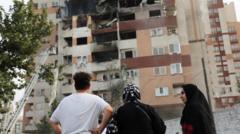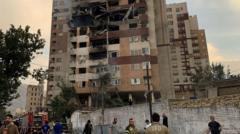#### Amid rising hostility, Israeli airstrikes have specifically targeted major Iranian nuclear sites, drawing international concern and condemnation.
### Recent Israeli Airstrikes Target Iranian Nuclear Sites

### Recent Israeli Airstrikes Target Iranian Nuclear Sites
#### Escalating tensions lead to attacks aimed at key Iranian nuclear facilities, intensifying the regional conflict.
---
Israel has intensified its military operations against Iran, focusing on crucial nuclear facilities spread throughout the country. This aggressive move, undertaken on the morning of June 13, 2025, has raised alarms globally, given the implications for regional stability. Iran's nuclear infrastructure, which includes deeply buried sites designed to withstand aerial attacks, faced direct threats as Israel struck at significant locations.
The incident highlights the ongoing volatility in Middle Eastern geopolitics, particularly surrounding nuclear proliferation. The Israeli military has aimed its firepower at key sites such as Natanz, known as Iran's principal uranium enrichment center. Approximately 140 miles south of Tehran, Natanz has been described as severely damaged in the strikes. The site is partially underground and is equipped with sophisticated centrifuges that enable Iran to enrich uranium at high levels. International observers note that there are about 14,000 centrifuges operational there, with additional units awaiting activation.
In a statement following the strikes, Rafael Grossi, the director general of the International Atomic Energy Agency (IAEA), confirmed that there had been no detected radiation leaks, but he condemned military actions that threaten the security of nuclear facilities. Emphasizing the potential harm to civilian populations, he categorically stated that "any military action that jeopardizes the safety and security of nuclear facilities risks grave consequences for the people of Iran, the region and beyond."
While Natanz was a primary target, Israel reportedly did not attempt to strike Fordow, a fortified site near Qom buried deep beneath a mountain, which would require advanced bombing techniques likely reliant on American military support. Fordow houses some of Iran's most advanced centrifuges, critical for enriching uranium to near weapon-grade levels.
Additionally, sites like Parchin, a military area suspected of past nuclear weaponization activities, and Bushehr, Iran’s only functional nuclear power plant, remain areas of concern. Iran denies any military nuclear ambitions, maintaining that its nuclear program is purely for energy purposes.
The international community continues to watch the developments closely as the potential for further escalation looms over the region, with peace negotiations and diplomatic solutions growing increasingly challenging.
Israel has intensified its military operations against Iran, focusing on crucial nuclear facilities spread throughout the country. This aggressive move, undertaken on the morning of June 13, 2025, has raised alarms globally, given the implications for regional stability. Iran's nuclear infrastructure, which includes deeply buried sites designed to withstand aerial attacks, faced direct threats as Israel struck at significant locations.
The incident highlights the ongoing volatility in Middle Eastern geopolitics, particularly surrounding nuclear proliferation. The Israeli military has aimed its firepower at key sites such as Natanz, known as Iran's principal uranium enrichment center. Approximately 140 miles south of Tehran, Natanz has been described as severely damaged in the strikes. The site is partially underground and is equipped with sophisticated centrifuges that enable Iran to enrich uranium at high levels. International observers note that there are about 14,000 centrifuges operational there, with additional units awaiting activation.
In a statement following the strikes, Rafael Grossi, the director general of the International Atomic Energy Agency (IAEA), confirmed that there had been no detected radiation leaks, but he condemned military actions that threaten the security of nuclear facilities. Emphasizing the potential harm to civilian populations, he categorically stated that "any military action that jeopardizes the safety and security of nuclear facilities risks grave consequences for the people of Iran, the region and beyond."
While Natanz was a primary target, Israel reportedly did not attempt to strike Fordow, a fortified site near Qom buried deep beneath a mountain, which would require advanced bombing techniques likely reliant on American military support. Fordow houses some of Iran's most advanced centrifuges, critical for enriching uranium to near weapon-grade levels.
Additionally, sites like Parchin, a military area suspected of past nuclear weaponization activities, and Bushehr, Iran’s only functional nuclear power plant, remain areas of concern. Iran denies any military nuclear ambitions, maintaining that its nuclear program is purely for energy purposes.
The international community continues to watch the developments closely as the potential for further escalation looms over the region, with peace negotiations and diplomatic solutions growing increasingly challenging.





















